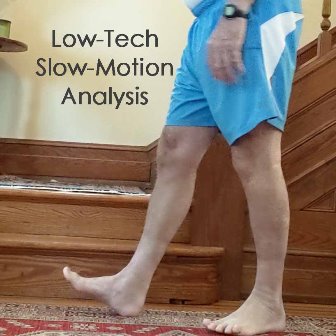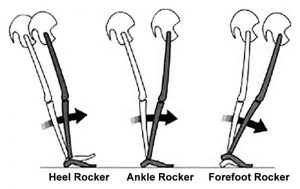Low-Tech Slow-Motion Analysis – “Dance Step to Nowhere

NDeviant movement during walking contributes to the development of or compensation for musculoskeletal pain syndromes. Diagnosis and treatment occur with visual observation and analysis of gait. The use of a smartphone video facilitates the analysis of motion walking. However, there are times when less technological motion analysis is necessary.
When dealing with painful musculoskeletal syndromes stance phase of gait is considered more important than the swing phase. A systematic gait analysis focused on the stance phase when walking or running can more effectively and efficiently diagnosis and treat painful musculoskeletal pain syndromes associated with walking and running.
Why the stance phase of gait is more important than the swing phase when dealing with painful musculoskeletal syndromes:
The stance phase is the period during which the lower extremity is in contact with the ground. The swing phase is the period in which the lower limb is not in contact with the ground. Double support is the period when both feet are in contact with the ground.
The magnitude of forces, the force per unit time, and the duration of applied force during the stance phase and energy expenditures are orders of magnitude larger than forces that occur during swing phase of gait. Forces in the swing limb are equal to the weight of the limb. Forces in stance limb vary between 1.5 to 3 times body weight. Stance limb force is during a noticeably short time, less than 0.6 seconds, a large shock. Duration of stance phase is longer than swing – stance is 60% of gait cycle. Stance and double support periods account for 71% of energy expenditure of the gait cycle. More work, time, energy is spent with the foot on the ground than in the air.
Movement during the stance phase can be classified according to 3 time periods: heel contact only, whole foot contact, and forefoot contact only.
The first period of stance is heel contact only, heel rocker, foot strike, or initial contact. Heel contact only: is Initial contact until the entire foot is on the ground.
The second period of stance is whole foot contact, ankle rocker, mid stance, or loading response. Whole foot contact is from the moment of entire foot contacts the ground until the heel rises from or peak ankle dorsiflexion
The third period of stance is forefoot only contact, forefoot rocker, terminal stance, or heel off to toe-off. Forefoot contact only begins at the onset of heel rise (ankle plantar flexion) and continues till toe-off.

Perry, Jacqueline - Slack N.J. 1992 - Three periods of stance phase of gait
The 3 time periods of stance (heel contact only, whole foot contact, and forefoot contact only) provide a classification to facilitate treatment.
Process of gait analysis:
This approach uses one camera, such as that in a smartphone, to record a person walking from the anterior/posterior view and from the right and left side of the body. Looking and analyzing the video recording in slow motion and frame by frame. Frame by frame identifies gait deviations occurring in each of the 3 times periods of stance. What is missing is what the subject is feeling during each of the 3 time periods of stance. A low-tech slow-motion analysis “dance step to nowhere” and/or “1/2 dance step to nowhere” can provide this detailed analysis.
If pain is on one side of the body, or if the pain is on both sides of the body pain on one side is greater than the other, utilize the dance step to nowhere.
The following is a description of the clinical exam/observation process using the low-tech slow-slow motion “dance step to nowhere” and “1/2 dance step to nowhere”. Observe from at least two views back to front and from the side and seek to identify gait deviations.
- Step forward and back with the painful (P) leg in the swing phase. The nonpainful (NP) leg will be in the stance phase supporting all the body weight.
- Pay attention to and remember what you see, and the client feels in the stance NP leg. The assumption is the movements in the NP stance leg are normal.
- Stop, next step forward and back with NP leg in swing phase. The P leg is in the stance phase, the NP leg is in the swing phase. The assumption there is a greater amount of forces occurring in the stance leg. Therefore, more likely to elicit pain and gait deviations.
- Pay attention to and remember what you see, and the client feels in the stance leg, which is the P leg, not the NP leg that is swinging and moving.
- Query what do you feel?
- Do you feel pain during only heel contact period?
- Do you feel pain during only forefoot contact period?
- Which period is the most painful?
- Repeat this process several times to demonstrate reliability in the observations.
Low-Tech Slow-Motion Analysis Dance Step to Nowhere
Systematically observe what each joint is doing starting at the back/pelvis region progressing down to toes, first the NP side, then looking at the P side.
Determine when the P stance leg is experiencing pain. Is it painful during heel only contact period, whole foot contact period, or forefoot contact only? To achieve this degree of detail may require using “1/2 dance step to nowhere”
Low-Tech Slow-Motion Analysis ½ Dance Step to Nowhere
Knowing which is the more painful period of stance will direct intervention. For example, pain during heel only contact period may need more shock absorption, shorter steps to decrease impact loading. Pain during whole foot contact period may need more stability and support. Pain during forefoot only contact period may need increase in strength and propulsive force, cue to “walk with more spring in your step”
Slow-motion video analysis, and low-tech slow-motion dance step to nowhere and ½ dance step to nowhere is an exam. Practicing an exam is a common learning method. Repeating the examination movements and using the feedback of knowledge of results facilitates altering deviant movements. Intervening and altering deviant movements when walking and running decreases and eliminates pain.
The information on this website is not intended or implied to be a substitute for professional medical advice, diagnosis or treatment. You are encouraged to perform additional research regarding any information contained on available through this website with other sources and consult with your physician.
Damien Howell Physical Therapy – 804-647-9499 – Fax: 866-879-8591 At-Home, At Office, At Fitness Facility – I come to you, I do home visits Damien@damienhowellpt.com
